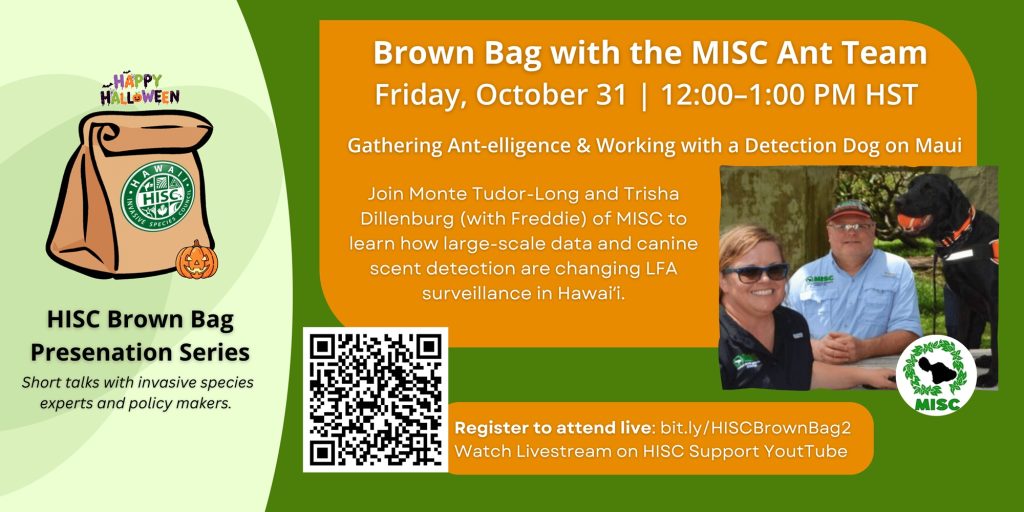HISC Brown Bag 36 – Stop the Ant Month: Ant Data & Detection Dogs with MISC Ant Team
Posted on Oct 13, 2025 in brownbag, News, slider
HISC Brown Bag Presentation Series #36
Stop the Ant Month – What 50,000 Ant Records Reveal & Working with a Detection Dog on Maui
Presenters:
Monte Tudor-Long, Maui Invasive Species Committee (MISC)
Trisha Dillenburg and Freddie, MISC Detection Dog Team
Date: Friday, October 31, 2025 | 12:00–1:00 PM HST
The recording of our latest HISC Brown Bag, Stop the Ant Month: Mapping Maui’s Ants and Training Detection Dogs, is now available. Watch the presentation starting with Monte Tudor-Long of the Maui Invasive Species Committee here
Session Overview
What do you learn after looking at tens of thousands of ant records under a microscope? And what does it take to work with a Little Fire Ant detection dog in the field? For Stop the Ant Month, the HISC Brown Bag Series features two applied talks from the Maui Invasive Species Committee (MISC) that show how large-scale data and canine scent detection are reshaping Little Fire Ant surveillance on Maui.
Part 1 – “Gathering ant-elligence, ant-icipating invasions and finding ant-swers: 2,000,000 ants collected on Maui establish a baseline.”
Presenter: Monte Tudor-Long, MISC
Nearly 70 species of ants have been documented in Hawaiʻi, all of which are believed to have arrived since the beginning of the 19th century. Since the arrival of those first ants, the number of species established here has grown at a seemingly inexorable rate of four new species per decade. The fact that many of our current ants are highly problematic species is well known. We also know that there are a number of destructive species eagerly waiting in the wings for an opportunity to invade our islands.
Today we have a reasonably good idea of which ant species are present somewhere in the archipelago, but what we lack is a clear understanding of which species are on which island, when they arrived on each island, and what any given ant’s distribution is on a given island. Over the past four years the Maui Invasive Species Committee, in documenting efforts to locate and eradicate Little Fire Ants from the island, has recorded density and species data for more than 50,000 ant detections across the island. This talk will discuss the immense quantity of geospatial and density data collected, the importance of collecting this data, and the case for identifying ants to species in every trap.
Part 2 – “The Nose Knows: Integrating Canine Detection Technique into MISC’s LFA Eradication Efforts.”
Presenter: Trisha Dillenburg, MISC (with Freddie, detection dog)
Maui’s biodiversity, agriculture, and quality of life. LFA are such a problem that they made the Global Invasive Species Database’s list of “100 of the World’s Worst Invasive Alien Species.” The Maui Invasive Species Committee (MISC) continues to develop and implement innovative tools for finding and treating LFA infestations in our efforts to eradicate this awful pest. Traditional survey methods, while essential, often miss small, scattered LFA populations, or use many precious resources trying to locate isolated remnant pockets of these tiny pests in a vast landscape.
Our newest survey tool, however, can literally sniff them out: enter Freddie, a scent detection dog that has been specially trained to detect LFA. Leveraging Freddie’s extraordinary olfactory capabilities and aptitude for fieldwork, MISC is building a detection dog program to enhance early detection and verification of LFA surveys. In the past year, we have continually developed Freddie’s skills and explored how he can be deployed effectively as a part of our survey team. While there have been unknowns and challenges, Freddie’s work has already proven valuable in the field. As the program evolves, we continue to learn how to best use his remarkable abilities and build on our successes. Working with a scent-detection dog has real-world challenges– it’s not all play and cuddles– but the potential benefits for invasive species eradication efforts are exciting and significant. Freddie can help us in our goals to increase detection rates, make surveys more efficient, and contribute to long-term biosecurity across Hawai‘i.
Missed the livestream? A recording will be posted following the event on the HISC Brown Bag YouTube Playlist.